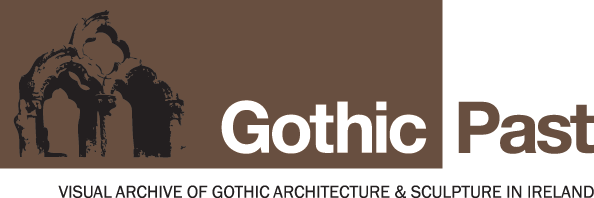Browse Items (37 total)
Sort by Title [A-Z] | [Z-A]
Athenry Dominican Priory, north chancel wall, sedilia, arch and hood
Jamb of sedilia, moulding from intrados comprises: hollow, roll-and-fillet, flat surface, roll-and-fillet, chamfer. The hood, from the outer edge, comprises: roll with frontal fillet, hollow flanked by fillets, quadrant. Few hollows flanked by fillets occur in Irish architecture, in England, Morris sees them as the progenitor of the casement -…
Athenry Dominican Priory, north chancel wall, sedilia, base
Base of sedilia, with two water-holding elements. From top down moulding comprises: necking roll-and-fillet, hollow, roll with upper fillet, hollow, roll with upper fillet, chamfer, plinth. Again, this might most readily be called debased Early English.
Athenry Dominican Priory, north chancel wall, sedilia, capital
Capital of sedilia shafts. complex moulding comprises from top down: roll-and-fillet, roll, angle-fillet, roll-and-fillet, roll, angle-fillet, roll-and-fillet, bell, necking roll-and-fillet. Four unit capital, perhaps fourteenth-century, best called degenerate Early English.
Athenry Dominican Priory, north chancel wall, sedilia, jamb
Moulding from intrados comprises: chamfer, roll-and-fillet, roll, partial roll.
Athenry Dominican Priory, north wall of north transept, wall arcade, arch and hood
Arch and hood of wall arcade. Moulding from intrados comprises: chamfer, hollow, triple-filleted roll, hollow, chamfer. The hood, from external to internal surface comprises: fillet, roll, hollow, roll, chamfer.
Athenry Dominican Priory, south aisle, north wall, wall arcade, mullion
Mullion of wall arcade, moulding comprises: frontal fillet flanked at either side by flat surface, fillet, hollow.
Athenry Dominican Priory, south nave wall, niche, arch and hood
Arch and hood moulding of eastern niche in south nave wall. Moulding of arch from inner to outer face comprises: hollow, roll-and-fillet, flat surface, roll-and-fillet, right-angled rebate, flat surface of wall. From outer to inner face, hood comprises: frontal fillet, hollow, hollow, quarter roll, hollow.
Athenry Dominican Priory, south nave wall, niche, arch and hood
Arch and hood moulding of westernmost niche of south nave wall. Arch moulding from inner surface comprises: chamfer, flat surface, hollow, roll-and-fillet, roll, hollow, chamfer, flat surface of wall. The hood, from outside face to inner comprises: roll-and-fillet, hollow, chamfer. The style of this moulding can best be described as debased Early…
Athenry Dominican Priory, south nave wall, niche, base
Base of middle niche in south wall of nave. Moulding is broken, but what remains, from top down, comprises: water-holding element, roll with two fillets, chamfer, plinth.
Athenry Dominican Priory, south nave wall, niche, base
A capital reused as a base. If read as a capital moulding comprises: roll-and-fillet, roll, dogtooth, roll, bell, necking roll.
Athenry Dominican Priory, south nave wall, niche, base
Base of eastern niche in south nave wall, from top down moulding comprises: roll, bell, roll and fillet, roll, plinth.
Athenry Dominican Priory, south nave wall, niche, capital
Capital of middle niche/sedilia of south nave wall, moulding from top down comprises: chamfer, fillet, hollow, stiff-leaf foliage, bell, necking roll-and-fillet. Here again Early English characteristics are manifest but the niche may date from the later middle ages.
Athenry Dominican Priory, south nave wall, niche, capital
Capital of niche, mouliding comprises from top down: roll-and-fillet, fillet, hollow, quadrant, fillet, hollow, roll with lower fillet, bell. The necking roll is missing.
Carron church, south door, jamb, arch and hood
Door jamb and arch moulding and hood, from intrados moulding comprises: quadrant, hollow chamfer, roll-and-fillet, hollow chamfer, quadrant. The hood comproses: hollow and angle-fillet.
Claregalway Franciscan Friary, north chancel wall, tomb niche, arch
Tomb niche in north nave wall. Moulding at inner surface has cusps, and from these outward comprises: fillet, three-quarter hollow, fillet, quadrant, fillet, chamfer (can be read as roll with two fillets), chamfer, right-angled rebate, quadrant, fillet, three-quarter hollow, fillet, quadrant, fillet, chamfer (can be read as roll with two fillets),…
Claregalway Franciscan Friary, north chancel wall, tomb niche, capital
Capital of tomb niche, from top down moulding comprises: roll-and-fillet, roll, angle-fillet, chamfer, chamfer, fillet, bell, necking roll.
Clontuskert Augustinian Priory, cloister, capital
Capital from reconstructed cloister, moulding from top down comprises: abacus, roll, roll, angle-fillet, roll-and-fillet, fillet, bell, necking roll-and-fillet.
Clontuskert Augustinian Priory, interior, east window, jamb
Jamb shaft running along reveal of east window. Moulding comprises, from angle: corner triple filleted roll flanked at either side by hollows and chamfers. This moulding looks Early English but is most likely fifteenth century, it looks similar to the work at Roscommon Dominican Friary, both in the jambs and in the tracery (both broken but…
Clontuskert Augustinian Priory, west door, jamb and arch
West door moulding, from soffit moulding comprises: roll-and-fillet, fillet, hollow, fillet, roll-and-fillet, fillet, hollow, fillet, roll-and-fillet, fillet, hollow, roll-and-fillet, fillet, pinnacle. This door, in its overall composition and the width of the fillets, is close to doors at Holycross, Kilcooly and other works related to them.
Corcomroe Cistercian Monastery, west door, jamb and arch
Door jamb and arch moulding, comprising from intrados: chamfer, hollow, triplet of roll-and-fillets, hollow, quadrant, quadrant. The hood comprises a sunk chamfer.




















